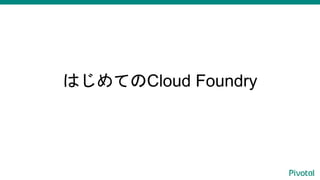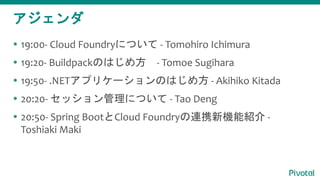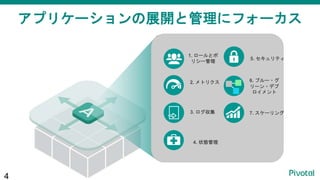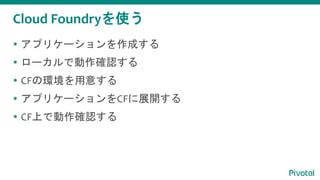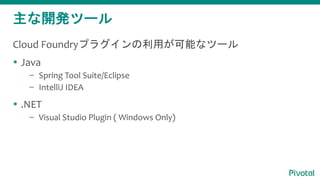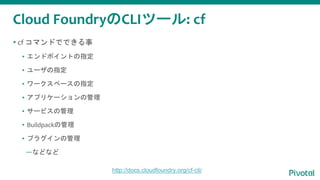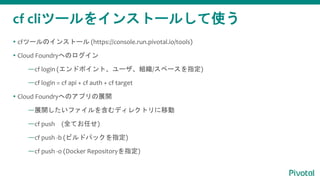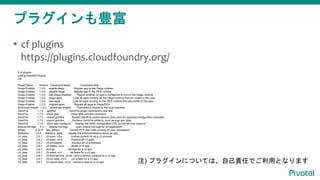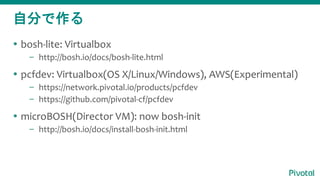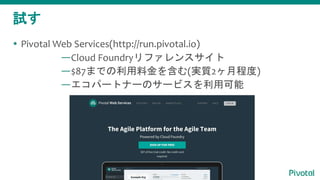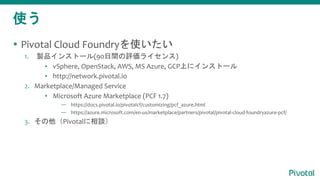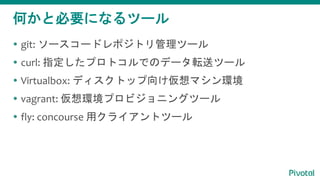Myfirst cloudfoundry intro_20161201
- 2. アジェンダ ? 19:00- Cloud Foundryについて - Tomohiro Ichimura ? 19:20- Buildpackのはじめ方 - Tomoe Sugihara ? 19:50- .NETアプリケーションのはじめ方 - Akihiko Kitada ? 20:20- セッション管理について - Tao Deng ? 20:50- Spring BootとCloud Foundryの連携新機能紹介 - Toshiaki Maki
- 3. これからのアプリケーション管理 3 開発 展開 スケジュール処理 オンデマンド アーキテクチャ 抽象化 “Day 2” Ops アプリケーションサー バ アプリけーションと 使い捨て可能なインフ ラ モノリシック アプリケーション マイクロサービス 線形 / シーケンシャル 短サイクル, テスト駆 動、反復 多くのツールと 部分的な自動化 サービス管理 (サーバ管理)
- 4. アプリケーションの展開と管理にフォーカス 4 4. 状態管理 2. メトリクス 3. ログ収集 1. ロールとポ リシー管理 5. セキュリティ 7. スケーリング 6. ブルー?グ リーン?デプ ロイメント
- 6. Cloud Foundryを使う ? アプリケーションを作成する ? ローカルで動作確認する ? CFの環境を用意する ? アプリケーションをCFに展開する ? CF上で動作確認する
- 7. 主な開発ツール Cloud Foundryプラグインの利用が可能なツール ? Java – Spring Tool Suite/Eclipse – IntelliJ IDEA ? .NET – Visual Studio Plugin ( Windows Only)
- 8. Cloud FoundryのCLIツール: cf ? cf コマンドでできる事 ? エンドポイントの指定 ? ユーザの指定 ? ワークスペースの指定 ? アプリケーションの管理 ? サービスの管理 ? Buildpackの管理 ? プラグインの管理 —などなど http://docs.cloudfoundry.org/cf-cli/
- 9. cfコマンドを使うために ? 必要な情報 —Cloud FoundryのAPIエンドポイント(Cloud Controller API URL) —ユーザ名 —パスワード —組織(Org) —ワークスペース(Space) ? cfコマンドと設定情報 —cf config --localeで言語指定が可能(ja-JP, en-US) —$CF_HOME/config.jsonにエンドポイントの情報を逐次保存 —$CF_HOMEは~/.cfがデフォルト
- 10. cf cliツールをインストールして使う ? cfツールのインストール (https://console.run.pivotal.io/tools) ? Cloud Foundryへのログイン —cf login (エンドポイント、ユーザ、組織/スペースを指定) —cf login = cf api + cf auth + cf target ? Cloud Foundryへのアプリの展開 —展開したいファイルを含むディレクトリに移動 —cf push (全てお任せ) —cf push -b (ビルドパックを指定) —cf push -o (Docker Repositoryを指定)
- 11. 慣れてきたら ? manifest.ymlの作成と管理 ? cfignoreによる無駄なアップロードの回避 ? buildpackの構成変更 – .bp-config – .profile ? 環境変数の設定 – JBP_CONFIG... https://docs.cloudfoundry.org/devguide/deploy-apps/manifest.html
- 12. プラグインも豊富 ? cf plugins https://plugins.cloudfoundry.org/ $ cf plugins Listing Installed Plugins... OK Plugin Name Version Command Name Command Help Diego-Enabler 1.2.0 enable-diego Migrate app to the Diego runtime Diego-Enabler 1.2.0 disable-diego Migrate app to the DEA runtime Diego-Enabler 1.2.0 has-diego-enabled Report whether an app is configured to run on the Diego runtime Diego-Enabler 1.2.0 diego-apps Lists all apps running on the Diego runtime that are visible to the user Diego-Enabler 1.2.0 dea-apps Lists all apps running on the DEA runtime that are visible to the user Diego-Enabler 1.2.0 migrate-apps Migrate all apps to Diego/DEA download-droplet 1.0.1 download-droplet Download a droplet to the local machine. GemFire 1.7.0 gemfire GemFire plugin command's help text GemFire 1.7.0 show-gfsh Show gfsh connect command GemFire 1.7.0 restart-gemfire Restart GemFire cache servers (Also used for applying configuration changes) GemFire 1.7.0 export-gemfire Retrieve GemFire artifacts, such as logs and stats GemFire 1.7.0 show-wan-config-url Display the WAN configuration URL for the service instance kibana-me-logs 0.3.1 kibana-me-logs open kibana-me-logs for an application pcfdev 0.22.0 dev, pcfdev Control PCF Dev VMs running on your workstation Statistics 1.0.0 statistics, stats display live metrics/statistics about an app v3_beta 0.6.7 v3-push, v3-p pushes current dir as a v3 process v3_beta 0.6.7 v3-apps, v3-a displays all v3 apps v3_beta 0.6.7 v3-processes displays all v3 processes v3_beta 0.6.7 v3-delete, v3-d delete a v3 app v3_beta 0.6.7 v3-logs tail logs for a v3 app v3_beta 0.6.7 v3-tasks, v3-t list tasks for a v3 app v3_beta 0.6.7 v3-bind-service, v3-bs bind a service instance to a v3 app v3_beta 0.6.7 v3-run-task, v3-rt run a task on a v3 app v3_beta 0.6.7 v3-cancel-task, v3-ct cancel a task on a v3 app 注) プラグインについては、自己責任でご利用となります
- 13. Cloud Foundryの環境 ? 自分で作る ? パブリックなサービスで試す ? 本格的に利用する
- 14. 自分で作る ? bosh-lite: Virtualbox – http://bosh.io/docs/bosh-lite.html ? pcfdev: Virtualbox(OS X/Linux/Windows), AWS(Experimental) – https://network.pivotal.io/products/pcfdev – https://github.com/pivotal-cf/pcfdev ? microBOSH(Director VM): now bosh-init – http://bosh.io/docs/install-bosh-init.html
- 15. 試す ? Pivotal Web Services(http://run.pivotal.io) —Cloud Foundryリファレンスサイト —$87までの利用料金を含む(実質2ヶ月程度) —エコパートナーのサービスを利用可能
- 17. 使う ? Pivotal Cloud Foundryを使いたい 1. 製品インストール(90日間の評価ライセンス) ? vSphere, OpenStack, AWS, MS Azure, GCP上にインストール ? http://network.pivotal.io 2. Marketplace/Managed Service ? Microsoft Azure Marketplace (PCF 1.7) — https://docs.pivotal.io/pivotalcf/customizing/pcf_azure.html — https://azure.microsoft.com/en-us/marketplace/partners/pivotal/pivotal-cloud-foundryazure-pcf/ 3. その他(Pivotalに相談)
- 18. 何かと必要になるツール ? git: ソースコードレポジトリ管理ツール ? curl: 指定したプロトコルでのデータ転送ツール ? Virtualbox: ディスクトップ向け仮想マシン環境 ? vagrant: 仮想環境プロビジョニングツール ? fly: concourse 用クライアントツール
